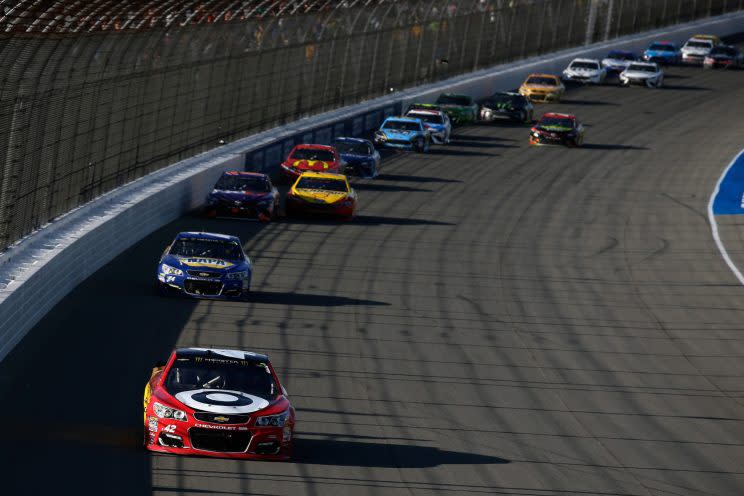Quick takeaways from Michigan: Has any track suffered more since its repave?
• The quality of racing at Michigan International Speedway isn’t what it once was.
The two-mile oval located not far from where NASCAR manufacturer stalwarts Chevrolet and Ford are located in Detroit used to be one of the most important races on the Cup schedule. While the track doesn’t have the cachet of a Daytona or Darlington, its layout was the perfect place for teams to find out who has the best combination of handling and horsepower. And what better place to do it than not far from the Motor City.
The track’s location hasn’t changed, nor has its length or banking. But the quality of racing hasn’t been what it once was since the track was repaved in the 2012 season. And the lack of Cup Series racing quality is hurting Michigan’s standing.
Repaves, as many NASCAR fans know, are inevitable. Even more so in a state like Michigan where temperatures can exceed 90 degrees in the summer and dip below zero in the winter. Such temperature swings take a toll on asphalt’s durability. The repave the track had before 2012 was its fourth.
But it may be the track’s most consequential, especially when coupled with the current aerodynamic and tire rules in the Cup Series.
Sunday’s race was a boring affair until a late debris caution bunched the field up and caused two subsequent restarts. Once cars got strung out after restarts single-file racing was the norm and tire wear was more nonexistent than anything else. Fourteen cars elected not to pit when that debris caution flew. Pre-2012 Michigan, everyone would have been heading to pit road for fresh tires.
But with speeds entering the corners at over 200 MPH and a grippy track, Goodyear brought a hard tire for teams. What the tire adds in durability — there were no failures Sunday — it takes away in tire wear. Two-tire stops were commonplace throughout the race.
Understandably, Goodyear doesn’t want to be responsible for a tire failure causing a crash as a car enters turn 1 at such high speeds. But that conservatism — even if it’s completely warranted because of the ridiculous downforce still created by Cup cars — comes with a price for fans, who clearly don’t care about racing at Michigan like they once did.
82,000 fans watched Dale Earnhardt Jr. win in the first race at the track since the latest repave. The track currently seats 71,000 and the grandstands Sunday looked roughly half full despite the commendations from Fox play-by-play broadcaster Mike Joy.
Yeah, attendance isn’t what it once was at many NASCAR tracks. Pocono and Dover both had swaths of empty seats, as have many other tracks this season. But at Michigan, it’s easy to look at Sunday’s race compared to ones seven years ago and figure out why fans wouldn’t want to spend money and time at the track any longer.
• Dale Earnhardt Jr. tweeted that the tools Michigan used to improve the grip in the corner was only used in the lower groove. Perhaps the race could have looked a lot different — and been more competitive — if the track had focused away from the main groove.
Running the tire monster before the event improved the grip, not to mention it wasn't used to work in a different groove. https://t.co/MnCOQoZjwr
— Dale Earnhardt Jr. (@DaleJr) June 19, 2017

• Kyle Larson’s win — and the way he went around Kyle Busch for the lead — is going to make Sunday’s race a fairly popular one. But the race would have been pretty unpopular if the field wasn’t bunched up with 15 laps to go because of that debris caution.
Many fans believe that debris cautions have previously been used as a tool by NASCAR officials to bunch up the field when convenient. And those fans would take glee in noting that with NASCAR’s new stage format producing two known cautions during every race, debris cautions are down significantly in 2017 compared to a year ago.
There were 21 debris cautions in 2016 through the first 15 races. The debris caution with 22 laps to go Sunday was the 12th of 2017. And if you were watching at home, you never even saw the debris that purportedly caused the caution anyway.
Tried to run next to it, possibly discard it off the racing surface cause I figured it was gonna result in a debris caution. Wouldn't budge. https://t.co/0E00yx9JKC
— Dale Earnhardt Jr. (@DaleJr) June 19, 2017
To be clear, we’re not alleging that NASCAR threw a fake debris caution late in Sunday’s race. What we are alleging is that it’s much easier for fans to scream about fake debris cautions when NASCAR’s television partners don’t show the debris the caution was thrown for. There was no public effort by Fox’s broadcast to show the debris after it was called.
That lack of effort is nothing new. It’s not unheard of for a broadcast to not show fans where debris is located on the track. But Sunday’s race deserved a much closer look. A caution was thrown on lap eight for a trash bag on the apron and a caution wasn’t thrown after that for what appeared to be a cowboy hat near the racing groove on the frontstretch.
Consistency is a lot to ask for from NASCAR on a number of issues. This shouldn’t be one of them. TV partners should be required to show fans where the debris is located or clearly admit they couldn’t do so. NASCAR’s credibility deserves it. Especially when a three-time Cup champion who was in attendance Sunday is even skeptical.
It's a shame that so many drivers and teams day was ruined by the results of another "debris" caution towards the end of the race today.
— Tony Stewart (@TonyStewart) June 18, 2017
• NASCAR also made an incredibly curious call to move its competition caution scheduled for lap 20 to lap 25 after the trash bag caution. The five-lap pushback would normally not be a big deal, but it was made after numerous teams at the back of the field — including Jimmie Johnson — came to pit road for tires early in the race.
If NASCAR wanted to move the competition caution it should have done so before pit road had opened. While five laps isn’t that big of a deal in the grand scheme of things, what it did to its teams and crew chiefs was still ridiculously unfair.
• Sunday’s race was the first time that Hendrick Motorsports had three cars in the top 10 since Texas on April 9.
– – – – – – –
Nick Bromberg is the editor of Dr. Saturday and From the Marbles on Yahoo Sports. Have a tip? Email him at nickbromberg@yahoo.com or follow him on Twitter!



